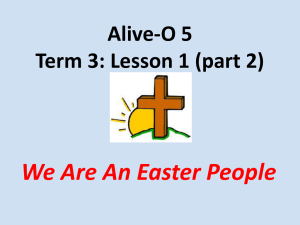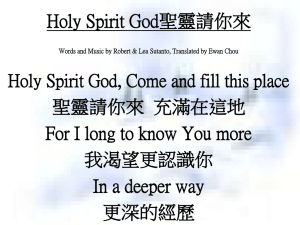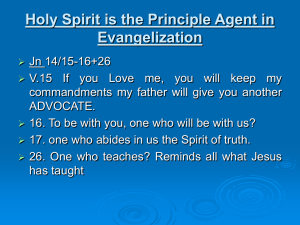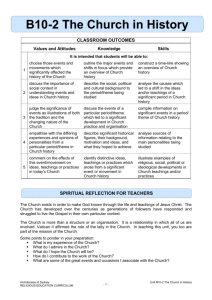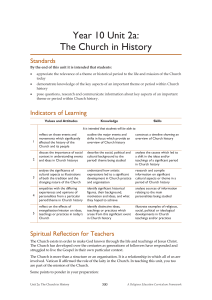Open
advertisement
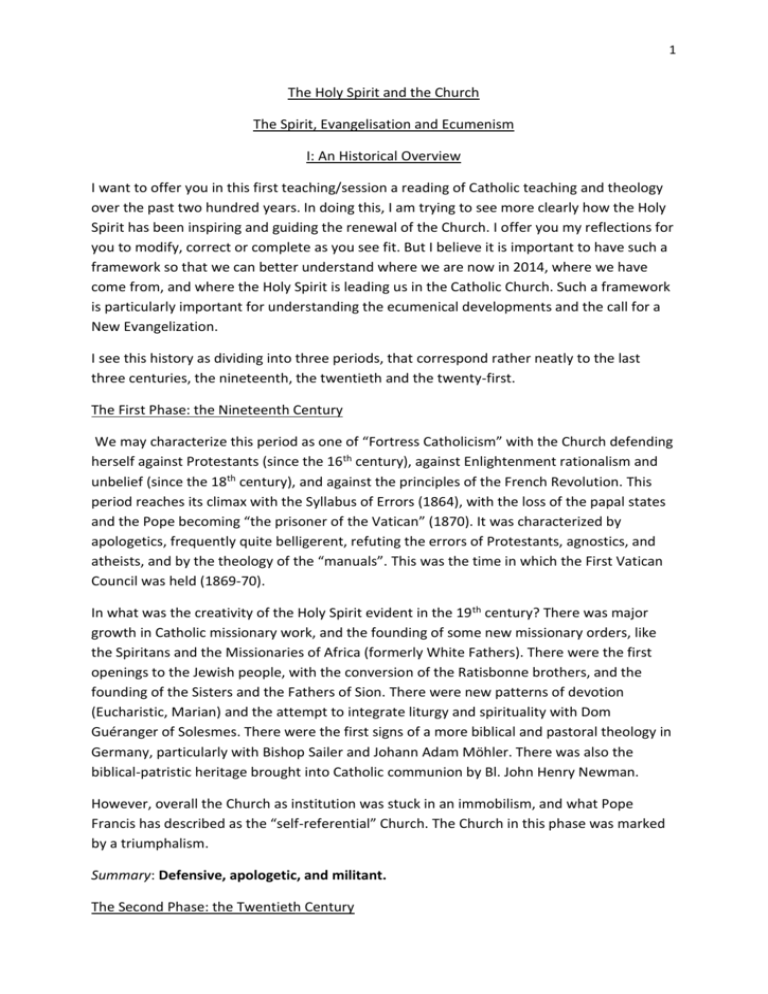
1 The Holy Spirit and the Church The Spirit, Evangelisation and Ecumenism I: An Historical Overview I want to offer you in this first teaching/session a reading of Catholic teaching and theology over the past two hundred years. In doing this, I am trying to see more clearly how the Holy Spirit has been inspiring and guiding the renewal of the Church. I offer you my reflections for you to modify, correct or complete as you see fit. But I believe it is important to have such a framework so that we can better understand where we are now in 2014, where we have come from, and where the Holy Spirit is leading us in the Catholic Church. Such a framework is particularly important for understanding the ecumenical developments and the call for a New Evangelization. I see this history as dividing into three periods, that correspond rather neatly to the last three centuries, the nineteenth, the twentieth and the twenty-first. The First Phase: the Nineteenth Century We may characterize this period as one of “Fortress Catholicism” with the Church defending herself against Protestants (since the 16th century), against Enlightenment rationalism and unbelief (since the 18th century), and against the principles of the French Revolution. This period reaches its climax with the Syllabus of Errors (1864), with the loss of the papal states and the Pope becoming “the prisoner of the Vatican” (1870). It was characterized by apologetics, frequently quite belligerent, refuting the errors of Protestants, agnostics, and atheists, and by the theology of the “manuals”. This was the time in which the First Vatican Council was held (1869-70). In what was the creativity of the Holy Spirit evident in the 19 th century? There was major growth in Catholic missionary work, and the founding of some new missionary orders, like the Spiritans and the Missionaries of Africa (formerly White Fathers). There were the first openings to the Jewish people, with the conversion of the Ratisbonne brothers, and the founding of the Sisters and the Fathers of Sion. There were new patterns of devotion (Eucharistic, Marian) and the attempt to integrate liturgy and spirituality with Dom Guéranger of Solesmes. There were the first signs of a more biblical and pastoral theology in Germany, particularly with Bishop Sailer and Johann Adam Möhler. There was also the biblical-patristic heritage brought into Catholic communion by Bl. John Henry Newman. However, overall the Church as institution was stuck in an immobilism, and what Pope Francis has described as the “self-referential” Church. The Church in this phase was marked by a triumphalism. Summary: Defensive, apologetic, and militant. The Second Phase: the Twentieth Century 2 In fact, the first stirrings of Church renewal start from the election of Leo XIII in 1878. Under Pope Leo, we find the Church beginning to open up to what develops more fully in the twentieth century and particularly in and through the Second Vatican Council. These elements include: The beginnings of Catholic Social Teaching The first encouragement of Catholic biblical scholarship (the encyclical Providentissimus Deus of 1893), a new edition of the Vulgate, and the founding of the Ecole Biblique in Jerusalem A greater awareness of the role of the Eastern Catholic Churches More attention to the Holy Spirit (the encyclical Divinum Illud Munus of 1897 and the consecration of the 20th century to the Holy Spirit) So looking at the decades of the twentieth century up to 1960 and the calling of the Second Vatican Council (1959), we see the following new developments: 1900 – 1909: Origins of the liturgical movement. 1910 – 1919: [Origin of the ecumenical movement among Protestants] Major efforts of Benedict XV for peace at time of World War I Attention to indigenization in missions (Benedict XV encyclical Maximum Illud 1919) 1920 – 1929: Malines Conversations with the Anglicans, founding of the Benedictine monastery of unity at Amay, later Chevetogne, Belgium First mobilization of the laity, canonization of St Therese of Lisieux 1930 – 1939: Pius XI social teaching (encyclical Quadragesimo Anno 1931) Josef Jungmann, sj (Austria) Book on kerygmatic renewal in catechetics Die Frohbotschaft und unsere Glaubensverkundigung (1936) The Whole Christ by Emile Mersch, sj and renewal of ecclesiology Ecumenical ministry of Abbe Couturier, Yves Congar, op Development of Lay Apostolate 1940 – 1949: Great encyclicals of Pius XII: on Scripture (Divino Afflante Spiritu, 1943), on the Church (Mystici Corporis Christi, 1943) and on Liturgy (Mediator Dei, 1947) – all prepare the way for Vatican II World War Two helps to break down inter-church barriers Founding of Series Sources Chrétiennes (H de Lubac,sj and J. Daniélou, sj) 3 Major developments in liturgical movement, founding of liturgical centres, etc Catholics can pray Our Father with other Christians (1949) 1950 – 1959: Continuing developments in theology, liturgy and lay apostolate Catholic Conference for Ecumenical Questions (from 1952) Restoration of Easter Vigil by Pius XII (1955) The Second Vatican Council (1962 - 1965) brings together the strands of Church renewal in its major documents: on the Liturgy, on the Church, on Divine Revelation, and on the Church in the Modern World. Liturgy: role of the Scriptures, Word and sacrament, liturgy expresses church, active participation, restoration of concelebration, restoration of catechumenate Church: biblical (roots in Israel),Trinitarian, ecclesiology of communion, People of God (historical), universal Church and particular church, primacy and collegiality, dignity and role of laity rooted in baptism, eschatological pilgrim Church, Mary as exemplar and icon of the Church Revelation: Person not propositions, Scripture and Tradition together (not separate sources), accepts a role for biblical criticism, open access to Scripture for the faithful, Scripture the soul of theology Church in Modern World: Open to work of Holy Spirit in the world, signs of the times, discernment not condemnation, Christ as God’s model for humanity, dialogue with all outside, new heavens and new earth Post-Vatican Two and St John Paul II. Since Vatican Two, among notable new developments have been New Ecclesial Movements, charismatic renewal, Evangelization (from Paul VI Evangelii Nuntiandi, 1975) leading to call for New Evangelization by St John Paul II, JPII preparation for new millennium, World Youth Days, JPII call for confession of Catholic sins, ecumenical dialogue as exchange of gifts not only ideas, JPII invitation concerning reform of the papacy (from Ut Unum Sint). Stabilization of Church following euphoria and upheaval of Vatican Two. Synthesis of Catholic teaching in the encyclicals of St John Paul II and in the Catechism of the Catholic Church. Contribution of philosophy of the human person. Integration of biblical framework, liturgical renewal, Trinitarian Christological and pneumatological ecclesiology, moral teaching and social teaching. All these elements have seen an increasing awareness of the Holy Spirit. Paul VI: The Holy Spirit as the principal agent of evangelization. St John Paul II encyclical Dominum et 4 Vivificantem (1986). Catechism: The Holy Spirit as the living memory of the Church (CCC 1099). Summary: Consolidation of Renewal of the Church that is biblical and liturgical, grounded in ecclesiology of communion at the service of the New Evangelization The Third Phase: The twenty-first century The third phase really becomes clear with the election of Pope Francis. (Benedict XVI can be seen as continuing the work of St John Paul II, and deepening it theologically.) How does the third phase advance from the second phase? First, through a Latin American pope making the Church less euro-centric, produces shifts in agenda and priorities Moving away from remaining patterns of imperial church and papal court Second, by summons to pastoral and missionary conversion of the whole life of the Church. Key words: Go out! To extremities and periphery! By lifting up of the option for the poor, the suffering and the dispossessed. From preached doctrine to radical living of the Gospel. Evangelization absolutely central but given new foci and emphases. For all, and by all. No to clericalism, yes to servant ministry. Ecumenism: grounded in relationships, in journeying together, in praying together. Reaping what the Holy Spirit has sown among other Christians (Evangelii Gaudium, 246).

